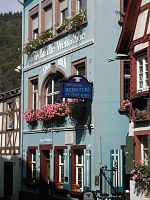Neckargemünd
show This article may be expanded with text translated from the corresponding article in German. (February 2009) Click [show] for important translation instructions. |
Neckargemünd | |
|---|---|
 View of the town | |
 Coat of arms | |
show Location of Neckargemünd within Rhein-Neckar-Kreis district | |
 Neckargemünd | |
| Coordinates: 49°23′38″N 08°47′51″E / 49.39389°N 8.79750°ECoordinates: 49°23′38″N 08°47′51″E / 49.39389°N 8.79750°E | |
| Country | Germany |
| State | Baden-Württemberg |
| Admin. region | Karlsruhe |
| District | Rhein-Neckar-Kreis |
| Government | |
| • Mayor | Frank Volk (FW) |
| Area | |
| • Total | 26.15 km2 (10.10 sq mi) |
| Elevation | 127 m (417 ft) |
| Population (2020-12-31)[1] | |
| • Total | 13,349 |
| • Density | 510/km2 (1,300/sq mi) |
| Time zone | UTC+01:00 (CET) |
| • Summer (DST) | UTC+02:00 (CEST) |
| Postal codes | 69151 |
| Dialling codes | 06223 |
| Vehicle registration | HD |
| Website | www.neckargemuend.de |
Neckargemünd is a town in Germany, in the district of Rhein-Neckar-Kreis, state of Baden-Württemberg. It lies on the Neckar, 10 km upriver from Heidelberg at the confluence with the river Elsenz.[2] This confluence of the two rivers is the origin of the name, as Neckargemünd means confluence of the Neckar. As of 2006, there were 14,122 inhabitants.
History[]
The region has been occupied by people for a half a million years as shown by the find of Homo heidelbergensis in nearby Mauer in 1907. Stone shards and stone axes have been found from the Early Stone Age. During Roman times the area was settled by Celts and Suebi. Grave stones from the 2nd and 3rd century in Kleingemünd show Celtic names. From the end of the 5th century the Franks held sway over the region. An iron spear tip and two iron arrow heads were left behind in Neckargemünd.[2]
Neckargemünd was founded in the 10th century, most likely as a fishing village. Neckargemünd was first mentioned by name in documents in 988. Otto III, Holy Roman Emperor enfeoffed Hildebald, Bishop of Worms, with the royal forests around Wimpfen and Neckarbischofsheim. Neckargemünd was named as the northwest corner of this area: a loco Gemundi ubi Elisinzia fluvius influit Neccaro fluvio. The counts of Lauffen also played a role in the region after making Dilsberg the seat of their domain.[2] Neckargemünd became a free town in 1286. In 1395 it passed to the elector palatine and, together with the surrounding district, became part of Baden in 1814.
Population development[]
Neckargemünd with Kleingemünd
| Year | 1439 | 1577 | 1688 | 1727 | 1818 | 1852 | 1905 | 1939 | 1965 |
|---|---|---|---|---|---|---|---|---|---|
| Population[3] | 295 | 855 | 550 | 877 | 1956 | 2702 | 2637 | 3862 | 8107 |
Neckargemünd with current boroughs
| Year | 1961 | 1970 | 1991 | 1995 | 2005 | 2010 | 2015 |
|---|---|---|---|---|---|---|---|
| Population[4] | 10.120 | 11.763 | 14.562 | 14.559 | 14.280 | 13.905 | 13.369 |
Boroughs[]
Neckargemünd includes a number of boroughs (Ortsteile) not part of the core settlement Neckargemünd.
- (1 January 1907) – independent from 1860-1906
- Dilsberg (1 January 1973) - a small historic village with a medieval castle ruin, the village includes Neuhof, Dilsbergerhof and Rainbach
- (1 January 1974)
- (1 January 1975)
Mayors[]
- 1855–1861: Georg Reibold
- 1862–1867: Julius Friedrich Menzer
- 1867–1873: Carl Heckmann
- 1873–1899: Carl Thilo
- 1899–1902: Carl Wittmann
- 1903–1909: Franz Heeg
- 1909–1910: Wilhelm Steinbrunn
- 1910–1917: Georg Schneider
- 1917–1919: Carl Kirchmayer
- 1919–1928: Dr. Emil Leist
- 1928–1939: Georg Müßig
- 1939–1942: Wilhelm Cloos
- 1942–1945: Gottfried Kramer (first vice mayor, then mayor)
- 1945–1948: Georg Lampertsdörfer
- 1948–1966: Heinrich Held (1948–1951 temporary)
- 1966–1984: Kurt Schieck
- 1984–2000: Oskar Schuster
- 2000-2016: Horst Althoff (CDU)
- 2016–: Frank Volk[5]
Twin towns – sister cities[]

Neckargemünd is twinned with:[6]
 Evian-les-Bains, France (1970)
Evian-les-Bains, France (1970) Missoula, United States (1993)
Missoula, United States (1993) Jindřichův Hradec, Czech Republic (1996)
Jindřichův Hradec, Czech Republic (1996) Romeno, Italy (1996)
Romeno, Italy (1996)
Neckargemünd also has friendly relations with Valeč in the Czech Republic.[6]
Notable people[]
- Rainer Ohlhauser (born 1941), footballer
References[]
- ^ "Bevölkerung nach Nationalität und Geschlecht am 31. Dezember 2020". Statistisches Landesamt Baden-Württemberg (in German). June 2021.
- ^ Jump up to: a b c "Stadtgeschichte Neckargemünd" (in German). Neckargemünd. Archived from the original on 19 July 2011. Retrieved 2 August 2010.
- ^ Kreisbeschreibung Bd. 2 S. 741: Neckargemünd mit Kleingemünd, ohne Dilsberg, Mückenloch und Waldhilsbach.
- ^ Kreisbeschreibung Bd. 2 S. 741: Neckargemünd mit Kleingemünd, ohne Dilsberg, Mückenloch und Waldhilsbach.
- ^ "Mit 50,9 Prozent wird Frank Volk Neckargemünds Bürgermeister".
- ^ Jump up to: a b "Partnerstlädte und Verbindungen". neckargemuend.de (in German). Neckargemünd. Retrieved 2021-06-04.
This article incorporates text from a publication now in the public domain: Chisholm, Hugh, ed. (1911). "Neckargemünd". Encyclopædia Britannica. 19 (11th ed.). Cambridge University Press. p. 337.
External links[]
- Towns in Baden-Württemberg
- Rhein-Neckar-Kreis



